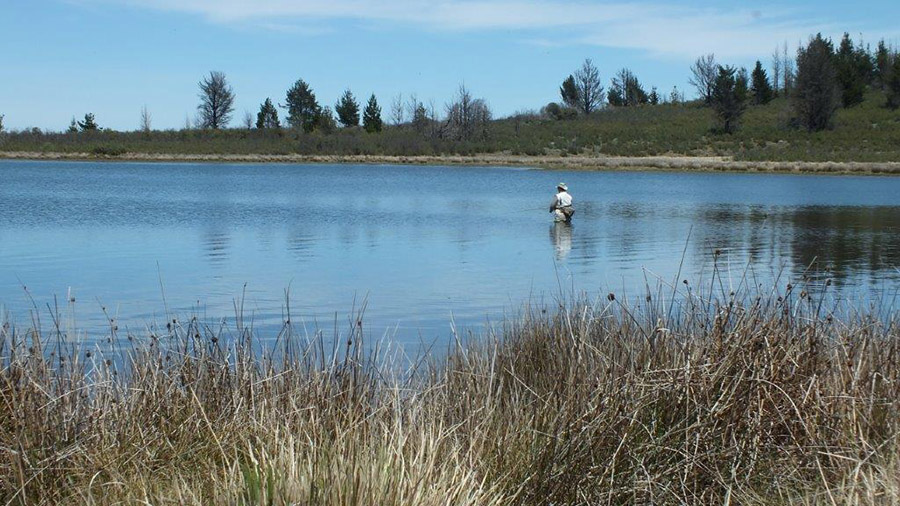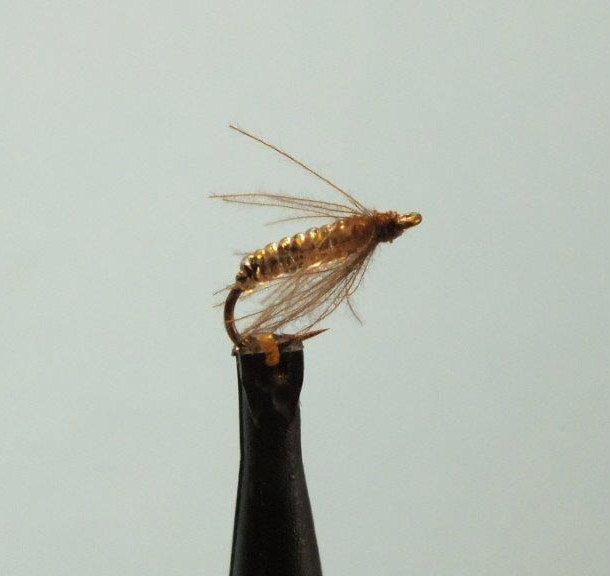In a recent discussion with Alan Hobson who guides from Somerset East on some of the exceptional trout dams in the area as well as at Sterkfontein Dam near Harrismith, he told me that some of his guests have only one way of fishing – double haul your fly as far as possible, put the rod butt in your armpit and ‘roly-poly’ retrieve as fast as possible.
Alan says most of his success for trout the Mountain Dam in Somerset East and Sterkfontein is with a size 18 pattern he calls the Phantom Emerger and which he developed to imitate the pupa of a small aquatic moth that hatches in profusion at both dams. He feels that trout and yellowfish take small patterns with less suspicion than bigger ones and he fishes them on the drift with an occasional slow figure of eight retrieve interspersed with small twitches.

Alan Hobson fishing the wind lane at Mountain Dam in Somerset East
Click in images to enlarge them
To me, the essence of trout fishing has always been to deceive the fish into believing that your fly is a food item rather than seeking to stimulate its aggressive instincts.
On dams, that means fishing your imitations extremely slowly and I have put together some extracts from British fly fishing books that emphasise this point.
I have hyperlinked the titles of the quoted books for further reference.

Alan Hobson fishing his Phantom Emerger on the drift at Sterkfontein Dam
STILLWATER TROUT TACTICS by Bob Church and Charles Jardine:
'To be really effective, early season nymph fishing must be done very slowly indeed. The less you move your flies, the more you will catch.'
Dr Peter Shelton (guest writer): 'For nymph fishing I must say that my success increased once I reduced the speed of the retrieve. My own experience of fishing buzzers at the waterside is that as long as the fly is moving it is impossible to retrieve it too slowly.'
SUCCESS WITH TROUT by Martin Cairncross, John Dawson, Chris Ogbourne:
'The caddis larva transports itself by a cluster of legs protruding from the front of the case at a rate which would make a snail look like an Olympic sprinter. When fishing a caddis larva imitation, therefore, the retrieve should be extremely slow. Five to ten minutes per cast is still much too fast for the natural, but should be slow enough not to raise too many alarm signals from the trout.'
MY WAY WITH TROUT by Arthur Cove:
'There are few actual nymphs that are true swimmers so most of us reservoir fishermen probably fish our imitations too fast anyway.'
'I noticed that although the bloodworm lashed about a lot in the water they never made any real progress through it and, like most of the other non-swimming nymphs, they were really at the mercy of wind and drift.'
CATCHING LAKE TROUT by John Gale:
'When I do start a retrieve, this usually takes the form of three or four figure-of-eights, then a longish pause before figure-of-eighting again. These pauses are vital for success and anyway, they leave the nymphs fishing in the likely area much longer than the continuous retrieves practised by most of the anglers I see.
Ninety percent of the anglers I watch fish their flies far too quickly, especially when nymphing.
'Fish your leaded nymph slowly or not at all for the best results. I cannot stress enough the importance of static nymph fishing. Nearly all the large, specimen trout I have caught over the years have been taken when I was doing nothing. Nothing except concentrating on my leader, that is.'

A Sterkfontein yelowfish taken by Alan on a dead drift on a Phantom Emerger
MASTERING THE NYMPH by Gordon Fraser:
'When anglers tell me that they can't catch on nymphs I always tell them to slow down the retrieve. It's amazing how often a dead drift on the wind will take fish when pulling won't. My dead drift tactics with nymphs have always outscored those with retrieved flies and the takes are more confident with this method.'

Alan Hobson’s Phantom Emerger which is one of his most successful patterns and which he ties for sale



